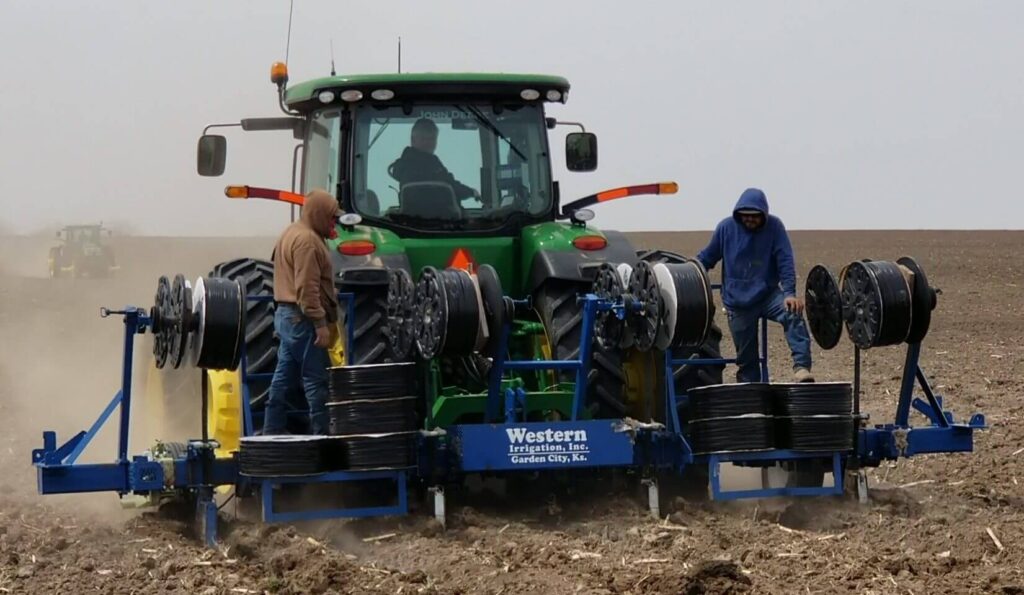Drip Irrigation for Corn Near Me York NB
As the world’s population continues to grow, the demand for food production is increasing. In particular, corn farming has become crucial in feeding a growing global population. However, with this increase in cultivation comes the need for efficient and sustainable irrigation methods. This is where drip irrigation comes into play as it offers many advantages over traditional irrigation systems. For corn farmers near you, switching to drip irrigation can significantly benefit both their crops and their overall farm operations. In this blog post, we will explore seven compelling reasons why drip irrigation for corn near York NB is essential and how it can help maximize yields while conserving resources and reducing labor costs.
Moisture where you need it
Moisture is an essential component for plant growth and ensuring that they receive the right amount of it can be a difficult task. Drip irrigation is a revolutionary watering system that aims to deliver precise moisture directly to plant roots where it is required the most. This innovative approach not only decreases water waste but also aids in conserving water resources.
The drip irrigation system features a network of tubes and emitters that distribute water directly at the root level of plants. This unique arrangement allows for precise and targeted watering while minimizing evaporation and runoff. As a result, plants get the necessary moisture they need without oversaturating the soil, which can cause diseases like root rot.
Additionally, drip irrigation can potentially save up to 60% of water usage compared to conventional watering methods. By regulating the amount of water consumed, farmers and gardeners can not only save water but also reduce energy and labor costs. Furthermore, this approach can also lead to healthier plant growth, higher crop yields, and increased sustainability.
Drip irrigation is a game-changing technology that delivers precise moisture directly to plant roots, reducing water waste and increasing plant growth. With the growing water scarcity issue, this innovative method allows for smart conservation of water resources, while ensuring the efficient growth of plants. Its impact on agriculture and gardening practices cannot be overstated, as it combines efficiency, sustainability, and environmental consciousness.
Increased yields
Increased yields in agriculture are always a welcome sight to farmers. With the right conditions, crops can produce robust and healthy plant growth that results in higher crop outputs for market distribution. One of the significant considerations in boosting crop yields is the presence of consistent moisture. Consistent moisture is vital as it provides crops with the water they need, creating an ideal environment for optimum growth and development.
When crops receive consistent moisture that is evenly distributed, they can thrive and produce higher yields. Properly watered crops have less stressed and healthier leaves, and as such, they can convert sunlight into energy efficiently. Additionally, consistent moisture can also provide the necessary nutrients that crops require for growth. This enables the plants to remain healthy, vigorous, and strong, increasing the number of harvestable crops.
Moreover, increased crop yields provide both social and economic benefits to farmers and consumers alike, putting more food on the market and securing food security in the future. With the population expected to increase in the coming decades, there is an increasing need to produce more food. Consistent moisture distribution plays a significant role in achieving this objective. We must continue to prioritize the provision of consistent moisture distribution in agriculture to achieve consistent higher crop yields.

Labor savings
The use of drip irrigation systems has been consistently lauded as a major labor-saving innovation by farmers and agricultural experts for years. Drip systems require minimal manual monitoring and maintenance compared to flood irrigation. This cutting-edge technology is known to provide a very efficient water management pattern that slowly and directly feeds plant roots, reducing evaporation and wastage. In effect, the systems help farmers lower their water usage and reduce the time and money it takes to cater to their irrigation needs.
The advantages of drip systems for labor-saving are two-fold. First, they minimize the need for a large labor force. With drip systems, farmers don’t have to use manual labor during the watering process, as the systems are designed to provide water directly to the roots over time. This saves time and labor costs associated with manual irrigation methods. Secondly, the lack of maintenance and manual monitoring requirements drastically reduces the operational costs of drip irrigation. This cost advantage cannot be overemphasized as it reduces operational risks, making the system much more affordable for small-scale farmers and agriculturalists.
Furthermore, the efficiency of drip irrigation systems is impressive. These systems carry out their work with minimal wastage, delivering irrigation water directly to the plant roots where it is needed most and consequently reducing the amount of water loss associated with flood irrigation methods. This is an important contribution to water conservation and ecologically friendly farm practices. Drip systems’ low manual intervention, low water usage, and operational efficiencies make them an attractive farming option for farmers who want to stay competitive, increase yields, and lower labor costs in an environmentally safe and sustainable manner.
Fertilizer efficiency
Fertilizer efficiency is a critical aspect of modern agriculture, aiming to maximize crop yield while minimizing the environmental impact. In recent times, drip irrigation has emerged as an effective method for enhancing fertilizer efficiency. This precision-based irrigation technique delivers water and fertilizers in small amounts directly to the root zone of plants, reducing the wastage of these essential nutrients. The result is a highly efficient system that produces more food with less water, energy, and chemical inputs, making drip irrigation a sustainable and environmentally friendly technique.
Apart from reducing fertilizer wastage, drip irrigation also minimizes the environmental risks associated with traditional irrigation techniques. Runoff from conventional irrigation systems can lead to soil erosion, water pollution, and nutrient loss that can harm local waterways and the ecosystem. Drip irrigation, on the other hand, delivers water and nutrients directly to the root of plants, minimizing the chances of runoff and soil erosion. This technique also reduces the need for pesticide and herbicide applications, reducing the chemical load on the soil and water sources, and improving overall soil quality and plant health.
Fertilizer efficiency by drip irrigation is a sustainable and efficient way to increase crop yield while reducing environmental risks. By delivering fertilizers directly to the roots and minimizing runoff, farmers can grow more with less and reduce the environmental impacts associated with conventional irrigation systems. With the rising global demand for food, drip irrigation is increasingly becoming a vital tool for farmers and the agricultural industry to sustainably meet the growing needs of the future.
Weed management
The use of drip irrigation for corn in weed management is gaining popularity due to its effectiveness in controlling unwanted weed growth. Low-volume, targeted watering removes the advantages of weeds that require flood irrigation to thrive. This is because drip irrigation delivers water directly to the plant’s roots, leaving the surrounding areas dry and uninhabitable for weeds. Additionally, the lack of surface moisture reduces the germination rate of weed seeds and prevents the spread of invasive weeds.
Research has shown that drip irrigation can significantly reduce weed populations and weed biomass compared to other irrigation methods. A study conducted by the University of California, Davis, found that drip irrigation reduced weed biomass by 91% compared to flood irrigation. This reduction was attributed to the precise application of low volumes of water directly to the crop’s root zone, resulting in minimal water loss and a reduced weed growth environment.
Furthermore, drip irrigation also reduces the likelihood of soil erosion caused by flooding, which can displace weed seeds and allow them to germinate in new areas. The absence of surface water also reduces the likelihood of weed seeds being transported by birds and other animals. As a result, drip irrigation provides an effective and sustainable solution for weed management, reducing the need for harmful herbicides and promoting a healthier ecosystem. The use of drip irrigation in weed management presents an innovative and effective method that addresses weed growth while promoting healthy crop growth and sustainability.

Adjustable to any terrain
Drip irrigation has revolutionized the way we approach watering plants by providing a more efficient and effective method that saves time, water, and money. One of the most important benefits of drip irrigation is the ability to adjust to any terrain with ease. Drip tape can contour uneven land, replacing difficult manual watering of hilly plots. This is extremely beneficial for farmers and agriculturalists who have to deal with challenging land topography.
Drip irrigation is a highly efficient delivery system that applies water directly to the root zone without wetting the leaves, plants, or soil. This reduces the loss of water due to evaporation, run-off, or percolation. Adjustable to any terrain by drip irrigation is a highly desirable feature that makes the system more effective and accessible. Unlike traditional irrigation systems, the use of drip irrigation on sloping terrain allows for more precise delivery of water, ensuring that all plants receive the same amount of water, irrespective of the slope and the type of soil.
The efficient use of water by drip irrigation on any terrain has significant environmental, economic, and social benefits. By reducing the amount of water used, farmers can save both water and energy. Moreover, it reduces nutrient leaching, and soil erosion, and ensures the proper distribution of fertilizers and chemicals. It also saves time and effort for the farmers, allowing them to focus on other important aspects of farming. Ultimately, adjustable to any terrain by drip Irrigation is an essential feature that makes drip irrigation an attractive choice for any type of landscape or topography.
Year-round protection
In the world of agriculture, protecting crops from extreme weather conditions is a constant challenge. But with Year-round protection by drip irrigation, farmers now have a permanent solution to defend their crops against frost, blizzards, and drought. This irrigation system provides a consistent and reliable source of water that supplies crops with the right amount of moisture they need to thrive and survive through variable conditions.
Drip irrigation is the most efficient irrigation technique as it delivers water directly to the root zone of crops, minimizing water wastage and maximizing nutrient uptake. Unlike traditional irrigation methods, drip irrigation systems are installed below ground, making them less prone to damage from severe weather, vandalism, or pest infestations. This technology regulates the delivery of the right amount of water, preventing over or under-watering and allowing for better control in timing the application of fertilizers, pesticides, and other crop-protecting substances.
Moreover, a well-equipped drip irrigation system can reduce labor costs significantly. By automating the process of watering and fertilizing, farmers can allocate more time to other essential tasks, like weed control, pest management, and crop harvesting. In addition, fewer laborers will be required to carry out these jobs, reducing overall expenses. With year-round protection by drip irrigation, farmers can still rely on a steady source of crop yields that support local and global food security, even in times of extreme weather conditions.
In conclusion, drip irrigation presents a compelling solution for modern farmers seeking efficient and sustainable methods of watering their crops. By delivering precise moisture directly to plant roots, this method reduces water waste and increases yields. It also offers labor savings, fertilizer efficiency, and weed management benefits. In addition, drip systems can be adjusted to any terrain, making it easier for farmers to maintain hilly plots without manual labor. With permanent below-ground systems providing year-round protection against extreme weather and frost, farmers can rest assured that their crops will thrive even in variable conditions. With all these advantages, it’s no wonder that more and more farmers are turning to drip irrigation as their preferred method of watering. So why not join the trend? Make the switch now and see the difference it can make in your farming practice. Let’s work together towards a greener and more sustainable future for agriculture.
